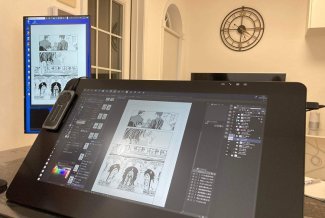Pupils from Los Feliz Charter School for the Arts leaving class on 20 February 2019.With some 275 charter schools, Los Angeles is the district with the highest number of independent charter schools in the US.
A young dancer with flowing movements is rehearsing a choreography on a large mat in the hall of Los Feliz Charter School for the Arts, near Hollywood. “He is our artist-in-residence. We created this space so that our pupils can observe him at their leisure,” whispers Varina Bleil, proudly, as she shows us around her school for children aged 5 to 12. A little further on, we come across a large orange shipping container where the school has set up a dance studio. “Not long ago, the children learnt about the solar system by imitating the positions of the planets,” she explains. “We have created an almost unique curriculum within the Californian public system that aims to integrate the arts into all the disciplines taught, be it earth sciences, literature, history or even maths.”
Although funded by the Californian taxpayer, Bleil’s innovative school is not exactly a public school. It is what is called a charter school in the United States, an establishment that is publicly-funded but privately-managed, some for profit, although these are a minority.
Founded by parents keen to provide their children with a free education in arts, Los Feliz Charter School for the Arts is a non-profit organisation, like most of these schools. “Ninety per cent of our financing comes from public funds. The remaining 10 per cent comes from donations from individuals, families or private foundations,” says the director. “Thanks to this additional funding, we can offer cutting-edge schooling, with a high-quality team composed of art specialists and psychologists who are attentive to the needs of each student. As we operate independently, we also have a great deal of freedom in terms of our approach to teaching and learning, which isn’t possible in a traditional public school.”
Criticised for years by public education advocates, these fast-growing institutions have been at the centre of a huge strike movement rallying public sector teachers that was launched in January and has spread across the country.
Teachers from states across the US, such as California, Colorado or West Virginia, accuse the charters of siphoning off funds and pupils from traditional public schools and of being partly responsible for the deterioration in their working conditions.
Public schools in a state of crisis – with class sizes of 40 to 50 students, inadequate school supplies, no nurses, psychologists or librarians – are now feeling increasingly threatened by these new establishments, which currently school over three million pupils in the United States.
As Ismael Armendariz, vice president of the Oakland Education Association (OEA), told the US magazine Mother Jones some weeks ago, public sector teachers are trapped in a vicious cycle. “When you’re not able to invest [editor’s note: in a public school], things like enrolment start to drop, and then as enrolment starts to drop, you have less funding. And so it just becomes a cycle where you lose enrolment, you’re losing funding, and then you have a higher concentration of kids who need support.”
In Los Angeles, 20 per cent of publicly-funded schools are now charters
Los Angeles is one of the main cities affected by this phenomenon. With some 275 charter schools, according to figures published by the Los Angeles Unified School District, it is the district with the highest number of independent charter schools in the United States. Charters account for around 20 per cent of the publicly-funded schools in the district, as compared with seven per cent just over ten years ago.
It was in the City of Angels that the teacher protest movement began, in January. Since then, it has snowballed, spreading to Denver, in Colorado, West Virginia, then to Oakland, California, in mid-February.
After a two-week battle, teachers in Oakland secured a promise of pay rises and smaller class sizes.
In Los Angeles, after a week-long strike (a rare occurrence in a city where teachers had not taken strike action for 30 years), the main teachers’ union United Teachers Los Angeles (UTLA) had already won a major victory: on 22 January, after five days of intense negotiations, the school district finally signed an agreement increasing teachers’ salaries by six per cent, promising to recruit education staff and opening the door to a future moratorium on new charters.
“I don’t think we should necessarily condemn charter schools and their initial purpose, which was to create centres for educational innovation [editor’s note: when they first appeared in the 1990s],” says Alex Caputo-Pearl, president of UTLA. “The problem is that today, these schools have become a real industry that is undermining the old system.”
Domino effect
This victory, won by some 30,000 striking teachers in Los Angeles, went on to inspire public school advocates in several other US states. In West Virginia, one of the seven states that do not permit charter schools, teachers’ unions have managed to block a bill seeking to give them legal existence.
In California, action taken by teachers from Los Angeles to Oakland also prompted the governor of the Golden State, Gavin Newsom, to call for a review on how the rise in charters is impacting the budget for traditional public schools.
Mike MeCey, spokesperson for California Parents for Public Virtual Education, an association promoting cyber charter schools in California, welcomes the prospect.
“I feel it is unfair to lay all the blame for the current crisis at the door of these schools before clear figures on the issue have been published,” says this father whose five children have been schooled within the different systems: public, private and cyber charter.
“Each type of schooling has catered to the different needs of my children. My son, who is studying through an online charter, had learning difficulties that he would not have been able to overcome in a traditional school, where he would not have been able to go at his own pace,” he explains. “In an ideal world, American public schools should be able to offer all students, regardless of who they are, the opportunity to succeed. But for the moment, unfortunately, that reality is still a long way off.”










